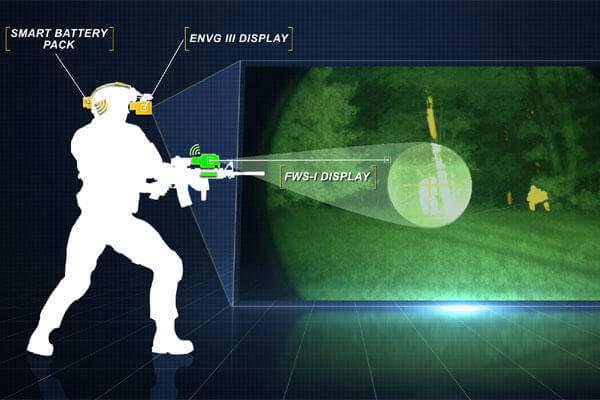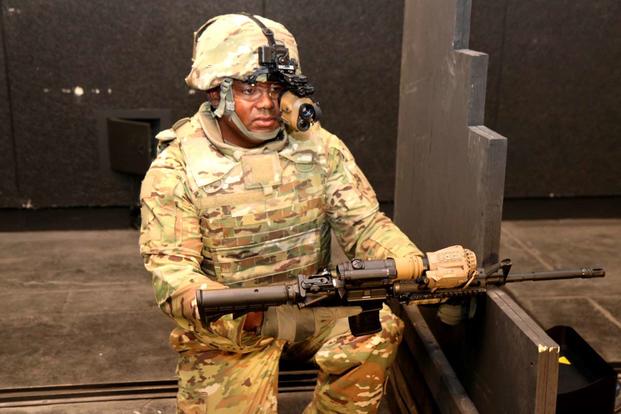After more than 20 years of attempts, the U.S. Army is now equipping infantrymen with a sophisticated sighting system that allows them to accurately shoot around corners without exposing themselves to enemy fire. But this futuristic capability, some say, may come at the cost of proficiency and could even result in more friendly-fire casualties.
Using a technology known as Rapid Target Acquisition (RTA), soldiers can see their weapon sight reticle wirelessly transmitted from a new thermal sight on the M4A1 carbine into their thermally enhanced night vision goggles, allowing them to see and quickly shoot enemy targets -- day or night, from the hip or lying behind cover and shooting over a wall.
"It's hard to express how much of a game-changing technology this is for our soldiers on the battlefield," Brig. Gen. Anthony Potts, commander of Program Executive Office Soldier, said during a recent interview.
Army officials promise the RTA technology has performed well in soldier testing. But military experts warn that if the service isn't careful, it could lead to an overreliance on technology, degrading critical marksmanship skills over time and increasing the risks of fratricide that come with ambiguity in thermal-spectrum detection.
Related: Army: New Wireless Sight Offers Leap-Ahead for Night Marksmanship
More and more challenges like this are likely to arise as the Army's extensive modernization effort begins to yield new capabilities that rely on advanced technology such as robotics, artificial intelligence and augmented reality to enhance soldier performance on the battlefield, they said.
"I think when new technologies come in, they enable people to do things that they weren't able to do before and to do current tasks more easily with less intent -- you don't have to concentrate as much," said Dakota Wood, a senior research fellow for Defense Programs at The Heritage Foundation. "Overreliance on technology can lead to lack of discipline and a lack of understanding of the fundamentals and skills that are needed when the technology isn't there to help you out."

A Long Way from Land Warrior
Army weapons officials have been trying to give soldiers the ability to shoot around corners since the late 1990s with Land Warrior, a program that relied on a wearable computer and advanced navigation and communications gear to give soldiers more situational awareness. The system allowed soldiers to see around corners with a weapon-mounted thermal camera that fed into a helmet-mounted heads-up display. Soldiers ultimately rejected it, however, because it relied on a tangle of bulky connecting cables that became snag hazards and restricted mobility.
In 2015, PEO Soldier officials unveiled a new take on this concept that eliminated bulky connector cables. Using a new Family of Weapon Sights-Individual (FWS-I), soldiers can wirelessly transmit their sight reticle into the wide display screen of the new helmet-mounted Enhanced Night Vision Goggle-Binocular (ENVG-B) and quickly fire at enemy targets.
Last September, the Army conducted a small fielding of the FWS-I and ENVG-B, along with other equipment at Fort Riley, Kansas, making the 1st Infantry Division's 2nd Brigade Combat Team the first unit in the service to receive Rapid Target Acquisition.
During testing, PEO Soldier officials saw a dramatic improvement in marksmanship when National Guard troops first shot with current optics and then used the Rapid Target Acquisition technology, Potts said.
"We went up to New Hampshire and we were working with the National Guard up there, and we put them through a stress shoot. ... And after they [had] been through a rigorous field exercise and they shot 40 targets," he said. "And on average, when we put them through that, they hit 17 out of 40. They were winded and people don't realize ... when you put people under simulated combat situations, shooting a target ain't as easy as people think it is."
After a couple of hours of training with the FWS-I and the ENVG-B, the soldiers showed marked improvement, hitting an average of 34 out of 40 targets after doing another rigorous fire-and-maneuver exercise, Potts said.
"It was a fire-and-maneuver exercise. It was up in the snow at night in New Hampshire, and you are talking about guys that are knocking down targets at over 200 meters at night, doing hip shots with this," he said. "You don't have to put the buttstock into your shoulder. He can stand behind a building; he can lay behind some rocks, put a weapon over his head and still engage targets."
Technology Can't Replace Marksmanship Fundamentals
This worries experts in the special operations world, because it goes against the fundamentals of marksmanship that have always been critical to engaging the enemy.
"You don't have the body behind the gun absorbing and managing recoil in the traditional manner that we teach soldiers how to control and manage recoil," said a former Army special operations forces soldier with expertise in small arms, visual augmentation systems and acquisition. "Firing a single round is one thing, but being able to control the weapon ... to be able to fire two or three or four rapid shots to ensure incapacitation of the threat is greatly diminished."
In a real combat situation, the soldier using this technology will be "swinging the weapon around in a non-intuitive manner ... until something that is hot zigzags across the field of view. And then he zigs the gun back, finds the heated thing, stabilizes the gun enough to break a single shot and then shoots the target," according to the former SOF soldier, who asked not to be named in order to speak freely. "So, everything that we teach them about daytime marksmanship, other than trigger control, is thrown out of the window."
Wood, who is a retired Marine officer, said the military has to guard against becoming overconfident in technology and continue to train on proven marksmanship techniques.
"I think that is really a danger, and it calls upon the Army and possibly the Marine Corps or others who start using these sorts of things to absolutely be rigid in ensuring discipline that marksmanship fundamentals are learned to begin with and then practiced on a regular basis, so that you can go analog and use the mechanical skills needed -- sight picture, trigger control, breathing," Wood said.
"When you bring in these super sophisticated sighting systems ... and you are just looking through a lens and wherever your weapon is pointing you see the dot, well what happens when that systems fails? Do you know how to go to iron sights? Do you know how to compensate for environmental factors that your computer mechanism might not be picking up?" he asked.
Potts told Military.com that he is confident that the Army will continue to train soldiers on time-tested marksmanship skills such as shooting with backup iron sights.
"One of the big debates in the Army for years is, we give the premier equipment that exists to who -- our special operators, who are our best trained people in the world," Potts said. "If you are going to put two people into combat, the 19-year old private or the 29-year-old sergeant ... to make it fair, you probably want to give the young guy all this new technology because he is not as skilled as this other guy."
The Thermal Blob and the Risks of Fratricide
Another potential minefield involved with this new sighting technology could emerge if soldiers begin relying too much on thermal signatures to identify targets, experts said, which can lead to fratricide.
Beyond 100 yards, human targets can look like heated blobs through thermal devices, making it impossible to differentiate between friend and foe, the SOF source said.
The Army's new ENVG-B can fuse both the infrared image intensification of traditional night vision and thermal into one image to get the best of both technologies, Army officials say.
"I think that thermal fusion is extremely effective; it eliminates some of the fratricide risks that come with thermal," the former SOF soldier said. "Now it becomes a training issue ... how rapidly can you fade between more thermal and less thermal.
"If you have the thermal cranked up in order to identify heat signatures, that overlay thermal image in the ENVG-B is going to reduce your ability to see clarity and definition in the image intensification, IR spectrum."
If soldiers have their thermal set to high, they won't be able to see "patterns of uniforms, curvature of the magazine on the rifle or whatever you are using to decide that it is an enemy combatant, not one of my fellow soldiers," he said.
Soldiers and leaders in armored units don't have the same problem because enemy tanks and vehicles can be easier to identify under thermal optics.
"When you're trying to find a tank at two kilometers and then be able to see, based off exhaust plume locations, what that vehicle is -- thermal helps you," the former SOF soldier said. "But human beings don't have telltale signatures of three road wheels and an exhaust pipe and the rear right thing that glows in this manner.
"Thermal gives you a bunch of capabilities, but it has its limitations, which is why I am encouraged about fusion," he said. "I think that fusion is the future. I just don't believe that digital fusion is where it needs to be right now from a technology standpoint."
The Army did not respond to a Military.com inquiry specifically about fratricide concerns with the new system.
The service is just beginning to produce more mature technologies as a result of the ambitious modernization effort it launched in 2017. It plans to field optionally manned robotic combat vehicles and new unmanned systems to send into the fray before risking its manned assets.
To be effective, Army leaders that they will have to rely on some level of artificial intelligence to enhance battlefield decision-making -- a prospect that some in the community warn could lead to deadly mistakes and unintended collateral damage if safeguards aren't in place.
The ENVG-B portion of Rapid Target Acquisition is a short-term capability that Army officials plan to begin trading in in 2021 for the new Integrated Visual Augmentation System (IVAS), an advanced Microsoft technology that relies on augmented reality to allow soldiers see a constant feed of battlefield information into special combat glasses, in addition to the sight reticle.
Time will tell if the Army can deliver on its promises and transition to new technology and advanced capabilities in a way that mitigates risks and maintains soldiers' proficiency.
Despite the concerns over RTA, Wood said it could be an effective battlefield tool.
"On the good side, more of your force could be more effective because you are not having to rely on everybody having extraordinary marksmanship skills," he said. "When everything is working, you are pointing the weapon, you are seeing where the dot is, and everybody is able to deliver fairly effective fire. That would be great, and I think that is where the proponents of something like this are going."
Potts said he is confident that the technologies such as RTA and IVAS will become more and more advanced with each new upgrade.
"People look at us and [think], 'Why can't you guys figure this out.' I want to say, 'Do you want to talk about the history of the smartphone and four decades ago what that looked like and how many of you have forgotten that you used to carry yours in the trunk of your car in a case,'" he said.
"If we had done it by the normal military acquisition system, we would have canceled the program three times," Potts said. "But the reality is no one will give up their smartphones. We are going to have a great product for our soldiers, and it's going to get better every time. We just have to have the tactical patience to get there."
-- Matthew Cox can be reached at matthew.cox@military.com.
Read More: This Wearable Device Could Replace Sand Tables for Soldiers













